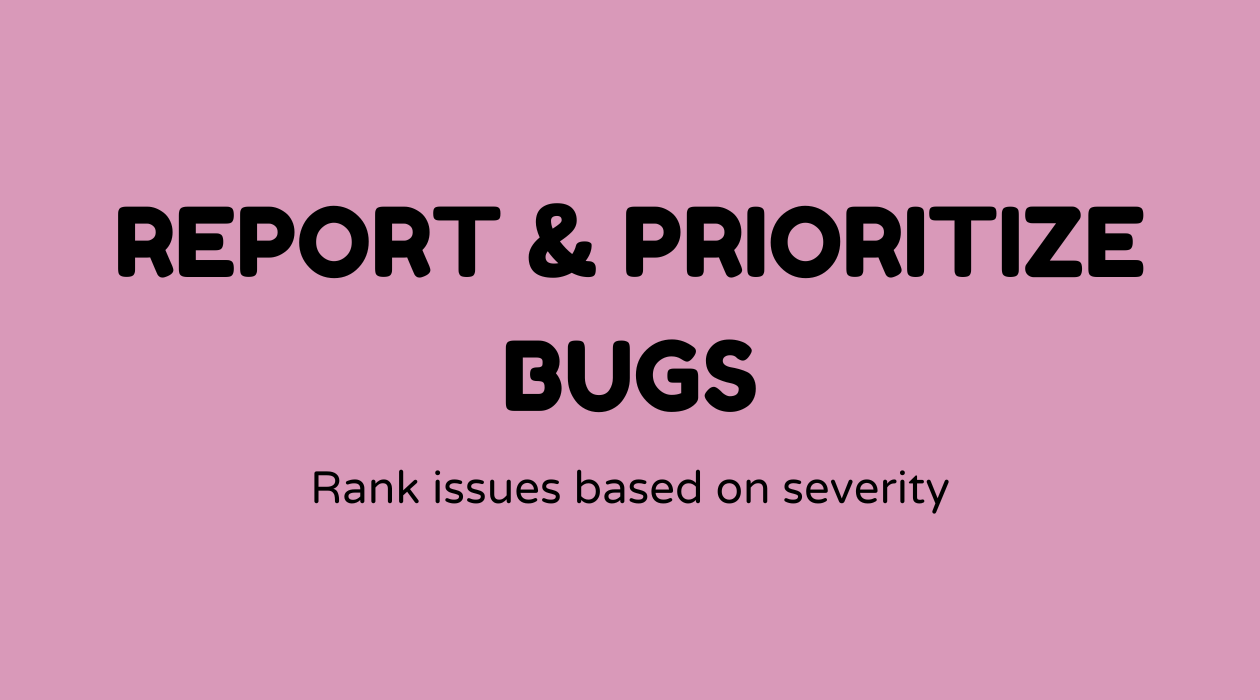Report and prioritize bugs and issues

Overview of Reporting and Prioritizing Bugs and Issues:
Addressing glitches, bugs, and other issues in software can feel chaotic. It’s essential to manage these challenges in an organized manner. This is where the process of reporting and prioritizing comes into action. It involves not only identifying problems but also evaluating, classifying, and addressing these issues in a structured way.
Why Reporting and Prioritizing Bugs and Issues Matters:
Why go through this process, you might wonder? In the competitive landscape of software development, a bug can range from a minor inconvenience to a significant obstacle. By prioritizing bugs and issues, teams can address the most urgent problems first, enhancing user satisfaction, preserving system integrity, and ultimately reducing expenses.
Moreover, ensuring transparency with stakeholders through effective reporting establishes trust and assures them that progress is being managed. It's an opportunity to highlight the ongoing efforts for improvement.
What is Reporting and Prioritizing Bugs and Issues:
What does this process entail? Reporting bugs involves documenting all details regarding any issues that occur—similar to filing a report for an incident in your software. This includes steps to reproduce the bug, what the expected results are, what actually happened, and any relevant visuals or logs.
Prioritizing issues means assigning a level of importance to each bug, usually based on its impact and urgency. This operates like a triage system in a medical setting. Does it represent a serious concern causing major service interruptions? Or is it a low-impact issue that does not affect core functionality?
How do you Report and Prioritize Bugs and Issues:
-
Identify and Replicate the Issue:
- Start by determining the exact problem. Can you reproduce it easily? Details are invaluable here.
-
Document the Bug:
- Use a consistent structure: Title, Steps to Reproduce, Expected vs. Actual Results, Environment Details, and Attachments such as screenshots.
-
Use Bug Tracking Tools:
- Utilize tools like JIRA, Bugzilla, or Trello to log and track issues. These tools provide platforms to classify and assign urgency levels.
-
Assess Impact and Severity:
- Figure out how the bug affects the system or user and assign a severity rating. High severity bugs typically hinder further progress.
-
Prioritize Based on Urgency and Business Needs:
- Align bug fixes with business objectives. Sometimes, a technical concern related to a product launch may require immediate attention.
-
Communicate Clearly:
- Take advantage of automated report generation capabilities in bug tracking tools to ensure clarity. Keep stakeholders updated through regular communication.
-
Re-assess Regularly:
- Review your list and modify prioritization based on new developments or changing business priorities.
Sample Agenda of Bug Reporting and Prioritization Workshop:
-
Introduction:
- Welcome and objectives of the workshop.
-
Session 1: Identifying and Reporting Bugs:
- Key elements of an effective bug report.
- Hands-on activity: Reporting bugs using sample data.
-
Break
-
Session 2: Prioritizing Bugs:
- Criteria for determining bug priority.
- Case study: Prioritizing a bug list.
-
Session 3: Using Tools for Reporting and Tracking:
- Tutorial on bug tracking tools.
- Activity: Logging and prioritizing a bug using these tools.
-
Wrap-up:
- Summary and Q&A.
Examples of Bug Reporting and Prioritizing:
-
Case Study - Tech Company X:
- After launching a new feature, users reported frequent crashes. With the bug reporting system, they discovered it mainly affected older operating systems. By prioritizing this issue, the team implemented a fix that enhanced user retention.
-
Scenario - Mobile App Development:
- A minor display issue didn’t impact performance and was marked as low priority. In contrast, a bug causing crashes during login was rated critical and resolved within hours.
FAQs
What makes a good bug report?
- An effective bug report includes a clear title, steps to reproduce, expected vs. actual outcomes, and relevant logs or screenshots.
How do you determine the priority of a bug?
- Priority is decided by the bug's effect on users, the software’s functionality, and how urgent it is to resolve based on business needs.
Why use a bug tracking tool?
- These tools aid in organizing and managing bugs efficiently, providing features such as automated updates, categorization, and reporting.
What happens if two bugs share the same priority?
- Teams need to reassess based on additional criteria like resource availability or strategic goals and refine their initial prioritization.
How often should bugs be re-assessed?
- It varies with the project's pace and changing needs, but generally, every sprint or project milestone is advisable.
Can a bug's priority change over time?
- Certainly! As projects evolve, business requirements may shift, or new information may become available, prompting a re-evaluation of priorities.



